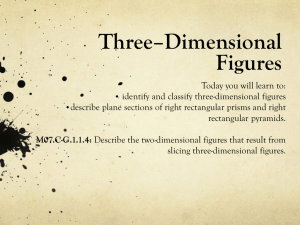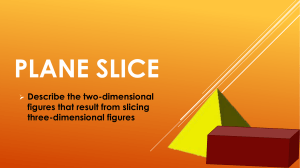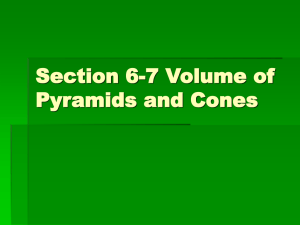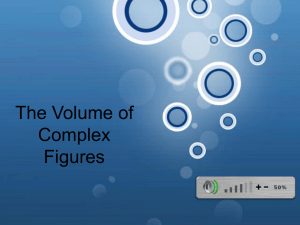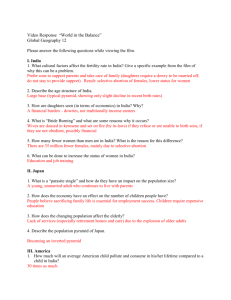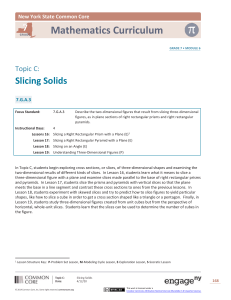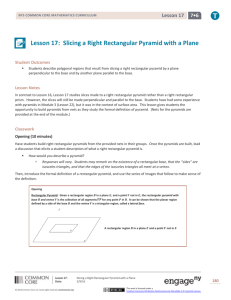7.G.3_11_29_12_final
advertisement
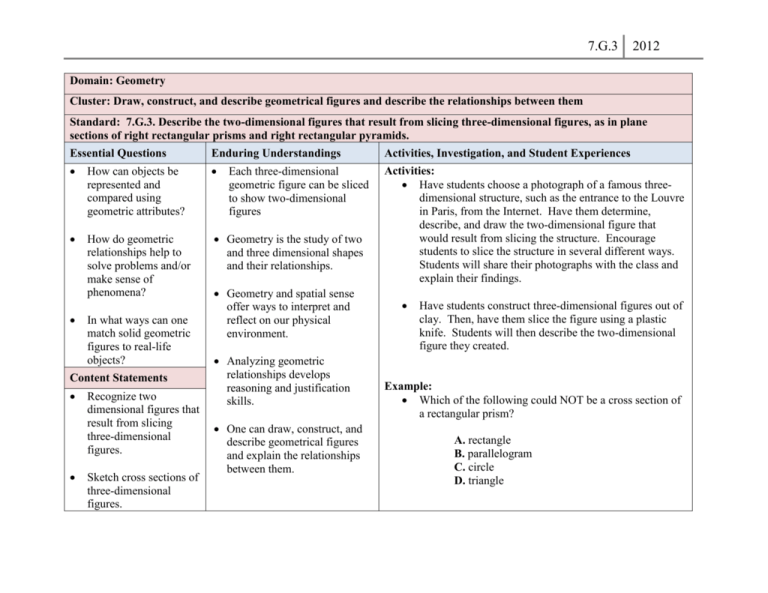
7.G.3 2012 Domain: Geometry Cluster: Draw, construct, and describe geometrical figures and describe the relationships between them Standard: 7.G.3. Describe the two-dimensional figures that result from slicing three-dimensional figures, as in plane sections of right rectangular prisms and right rectangular pyramids. Essential Questions Enduring Understandings Activities, Investigation, and Student Experiences How can objects be represented and compared using geometric attributes? How do geometric relationships help to solve problems and/or make sense of phenomena? Geometry is the study of two and three dimensional shapes and their relationships. Activities: Have students choose a photograph of a famous threedimensional structure, such as the entrance to the Louvre in Paris, from the Internet. Have them determine, describe, and draw the two-dimensional figure that would result from slicing the structure. Encourage students to slice the structure in several different ways. Students will share their photographs with the class and explain their findings. In what ways can one match solid geometric figures to real-life objects? Content Statements Recognize two dimensional figures that result from slicing three-dimensional figures. Sketch cross sections of three-dimensional figures. Each three-dimensional geometric figure can be sliced to show two-dimensional figures Geometry and spatial sense offer ways to interpret and reflect on our physical environment. Analyzing geometric relationships develops reasoning and justification skills. One can draw, construct, and describe geometrical figures and explain the relationships between them. Have students construct three-dimensional figures out of clay. Then, have them slice the figure using a plastic knife. Students will then describe the two-dimensional figure they created. Example: Which of the following could NOT be a cross section of a rectangular prism? A. rectangle B. parallelogram C. circle D. triangle 7.G.3 Assessments 2012 Investigation: If the pyramid is cut with a plane (green) parallel to the base, the intersection of the pyramid and the plane is a square cross section (red). A square pyramid is shown. The base of the pyramid has an area of 25 square inches. a.) A plane slices through the pyramid. It forms a cross section that is a square with an area of 9 square inches. Describe how the plane cut through the pyramid. b.) A plane that is perpendicular to the pyramid’s base slices through the pyramid. It passes through the pyramid’s vertex. What shape is the cross section? If the pyramid is cut with a plane (green) passing through the top vertex and perpendicular to the base, the intersection of the pyramid and the plane is a triangular cross section (red). Name the following cross sections formed. a.) The top of a rectangular pyramid is sliced through. b.) A right rectangular to the base. If the pyramid is cut with a plane (green) perpendicular to the base, but not through the top vertex, the intersection of the pyramid is sliced from the apex pyramid and the plane is a trapezoidal cross section (red). 7.G.3 2012 c.) A right rectangular prism is sliced resulting in the formation of two congruent right rectangular prisms. http://intermath.coe.uga.edu/dictnary/descript.asp?termID=95 Equipment Needed: Teacher Resources: Pen/Pencil http://nlvm.usu.edu Paper http://Illuminations.nctm.org Ruler http://www.ncpublicschools.org/docs/acre/standards/c ommon-core-tools/unpacking/math/7th.pdf Internet http://insidemathematics.org/index.php/7th-grade Overhead http://www.illustrativemathematics.org/standards/k8 http://www.khanacademy.org/search?page_search_q uery=geometry http://www.schools.utah.gov/CURR/mathsec/Core/7th -Grade-Core/7G1.aspx Reference books Graphing calculator Interactive whiteboard Online Activities Worksheets Clay Graph Paper
